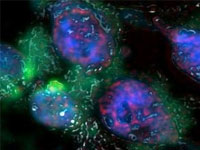
对癌症进行传统化疗中,由于药物作用的对象是快速分裂的细胞,而骨髓里正常的细胞也具有快速分裂的特性,因此药物在杀死快速分裂的癌细胞时,也能杀死大量正常细胞。
美国加州理工学院应用和计算数学系副教授奈尔斯.皮尔斯(Niles Pierce)及其同事设计了一种新方法――杂交连锁反应转导(HCR transduction),该方法利用小RNA来程序化地识别特定癌细胞并且诱导其自身瓦解,可以避免传统化疗所带来的副作用。相关论文发表在9月6日出版的美国《国家科学院院刊》(PNAS)上。
该方法利用了两种不同类的条件性小RNA(比如:A和B)。其中一个小RNA(A)设计为和特殊癌细胞中突变RNA部分互补,以使最终能够结合到该癌细胞的RNA上。小RNA(A)必须打开发夹结构才能结合癌细胞RNA上,同时,打开发夹的小RNA(A)也能够自然地与另一个打开发夹小RNA(B)结合。这样形成的裸露双链RNA聚合体激发了细胞中蛋白激酶R(PKR)主导的天然抗病毒免疫反应,诱导细胞凋亡程序,从而清除癌细胞。
皮尔斯在三种类型的癌(胶质母细胞瘤,前列腺癌和尤文氏肉瘤)细胞中进行试验,结果使癌细胞数量成20-100倍下降。然而,皮尔斯说,条件性小RNA治疗能否应用于病人身上还需继续研究。(科学网 任春晓/编译)(生物谷Bioon.com)
生物谷推荐英文摘要:
PNAS doi: 10.1073/pnas.1006377107
Selective cell death mediated by small conditional RNAs
Suvir Venkataramana, Robert M. Dirksa,b, Christine T. Uedab, and Niles A. Piercea,c,1
aDepartment of Bioengineering;
bDepartment of Chemistry; and
cDepartment of Applied and Computational Mathematics, California Institute of Technology, Pasadena, CA 91125
Cancer cells are characterized by genetic mutations that deregulate cell proliferation and suppress cell death. To arrest the uncontrolled replication of malignant cells, conventional chemotherapies systemically disrupt cell division, causing diverse and often severe side effects as a result of collateral damage to normal cells. Seeking to address this shortcoming, we pursue therapeutic regulation that is conditional, activating selectively in cancer cells. This functionality is achieved using small conditional RNAs that interact and change conformation to mechanically transduce between detection of a cancer mutation and activation of a therapeutic pathway. Here, we describe small conditional RNAs that undergo hybridization chain reactions (HCR) to induce cell death via an innate immune response if and only if a cognate mRNA cancer marker is detected within a cell. The sequences of the small conditional RNAs can be designed to accept different mRNA markers as inputs to HCR transduction, providing a programmable framework for selective killing of diverse cancer cells. In cultured human cancer cells (glioblastoma, prostate carcinoma, Ewing’s sarcoma), HCR transduction mediates cell death with striking efficacy and selectivity, yielding a 20- to 100-fold reduction in population for cells containing a cognate marker, and no measurable reduction otherwise. Our results indicate that programmable mechanical transduction with small conditional RNAs represents a fundamental principle for exploring therapeutic conditional regulation in living cells.







